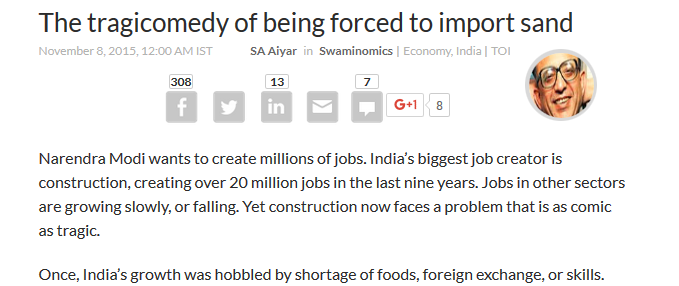Narendra Modi wants to create millions of jobs. India’s biggest job creator is construction, creating over 20 million jobs in the last nine years. Jobs in other sectors are growing slowly, or falling. Yet construction now faces a problem that is as comic as tragic.
Once, India’s growth was hobbled by shortage of foods, foreign exchange, or skills. But now we have a bewildering new shortage: a shortage of sand.
Wooden environmental regulations, bureaucratic overcaution, plus a politician-mafia nexus, have created this shortage. Sand is mixed with cement and gravel to produce concrete. Without concrete, construction will grind to a halt.
Two years ago, I wrote that if the sand shortage continued, India would soon be importing sand. This invoked much mirth. One reader said when Saudi Arabia runs out of oil, it can stay rich by exporting sand to India.
This is no longer a joke. Last month, Maharashtra started importing sand from Indonesia and the Philippines. One ship with 50,000 tonnes of sand has landed, and more are coming. Just imagine, a country with silted rivers and canals, with all the sand of the Arabian Sea and Bay of Bengal, is importing sand from distant lands. Can there be a worse example of regulations gone haywire?
Two years ago, the sand mafia used its political clout to force the suspension of Durga Shakti, an IAS officer who tried to stand up to illegal sand mining in Uttar Pradesh. The media and Opposition politicians were outraged. The National Green Tribunal responded by tightening even further the rules for legal mining. It banned sand mining on even the smallest areas without clearance from the Ministry of Environment and Forests or the State Environment Impact Assessment Authority.
This was well-intentioned. But curbing legal mining does nothing to reduce illegal mining. Indeed, curbs on legal mining have worsened the sand scarcity, and made illegal mining more profitable than ever.
Such problems often arise with judicial over-reach, when courts begins to issue executive orders. Courts are designed to judge whether something is right or wrong. They are not designed to make policies that ensure adequate supplies while checking environmental excesses. The courts are not accountable to anybody if their rulings create a sand shortage, or make illegal mining more profitable than ever.
Sand helps rivers absorb water in the rainy season and release it in the lean months. Hence excessive sand mining can damage river flows, and must be checked. But the answer is not to simply ban mining. Rules must be framed to greatly expand legal mining, and ensure that the needs of a growing economy are met. India is still a poor country with a low rate of construction. What will happen if GDP keeps expanding fast, and India soon needs thrice the sand we use today? No court, NGO or TV anchor seems bothered about that.
State governments issue licences for sand to be mined from rivers and tanks. Politicians in the past have, notoriously, demanded bribes for sand mining licences. After the anticorruption movement of Anna Hazare and intervention of courts, this has become difficult, and a new problem has arisen. District officials in UP say the National Green Tribunal’s rules are not clear-cut, and leave room for different interpretations. So, to avoid any corruption accusations, many officials have simply stopped issuing new licences.
After the Durga Shakti incident, one news report said Uttar Pradesh used to allot 2,800-3,000 leases per year for mining sand, gravel and boulders, but this had come down to 1,900. One official said that in four districts, old leases expired and no new ones at all were issued. UP is not alone: other states are following suit.
Mumbai builders say the sand scarcity has sent its price soaring from Rs 5,000 to Rs 13,000 per 100 cu ft. Imported sand will cost Rs 20,000, but there is no legal alternative. New Delhi seems to have ignored the problem since sand is a minor mineral, falling under the jurisdiction of state governments. But the sand shortage is now affecting all construction, and even the balance of payments.
A national plan is urgently required to step up the supply of legal sand. The sand mafia will disappear if legal supplies are plentiful. Regulated desilting of rivers, reservoirs and canals can yield large amounts of sand for construction without causing environmental damage. Dredging to build new ports and maintain old ones will yield ample sand for coastal towns. Environmental rules today curb offshore sand mining, and need intelligent liberalization. Why go to Indonesia or the Philippines for sand when trillions of tonnes are available along the coastline, and billions more are available in silted rivers and canals?



ban on mines for garvel & sand from river & minor hills is polluting more as in NCR construction material is imported from Rajasthan, more than 400kms away, making it more costly, burning POL & prone to more accidents. Use this money for more plantitation as spreading of desert towards NCR has been checked earlier.
Great research ..Thank u !